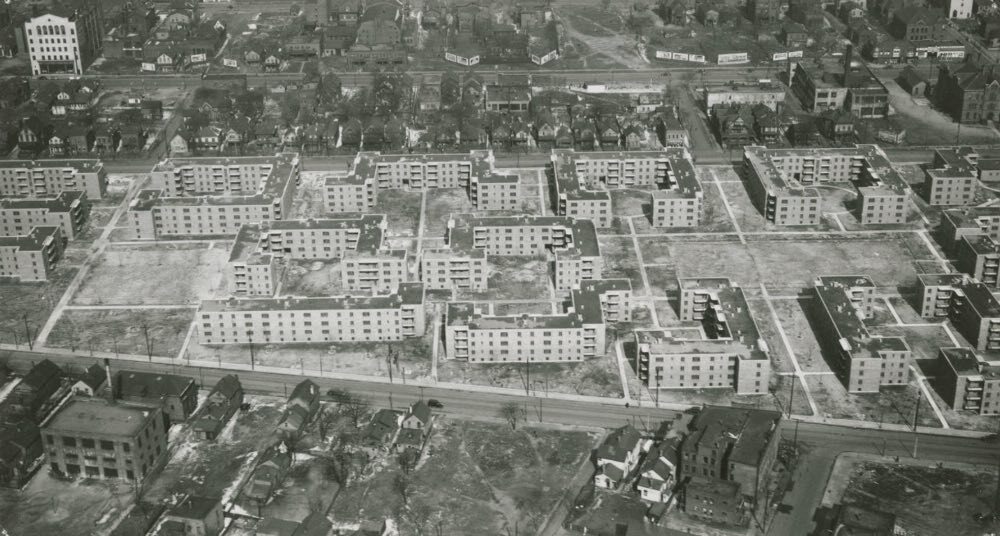Cedar-Central Apartments
Ernest Bohn's "Housing Laboratory" and the Legacy of Public Housing

In the depths of the Great Depression when urban housing conditions were desperate, Ernest J. Bohn, then in his early thirties, emerged as a champion of housing reform. Bohn, who had come to Cleveland from Hungary with his parents in 1911, was elected to the Ohio House of Representatives just as the stock market collapsed. Dismayed by the effects of poverty and substandard housing on urban social problems and impelled by his deep Catholic faith, Bohn resolved to bring change. By 1933, as a city councilman, he had written and shepherded to passage the first state public housing enabling legislation in the United States, resulting in the formation of the Cleveland (later Cuyahoga) Metropolitan Housing Authority (CMHA). He drew attention to the plight of the poor by supporting Father Robert B. Navin’s study of Cleveland’s Cedar-Central neighborhood, “The Analysis of a Slum Area in Cleveland,” which exposed the cost to the city of allowing such conditions and became influential in shaping national public housing policy. One of the fruits of his labor was Cedar-Central Apartments, one of the three earliest public housing projects in Cleveland to garner federal funding, and among the first nationwide.
The conditions that led to Cedar-Central Apartments as a first step toward remediating the conditions that Fr. Navins’s study exposed were a product of rampant urban growth and social inequality. Cleveland’s population had doubled to nearly 800,000 in the first twenty years of the 20th century. This increased the housing inequities in the city, with many people being forced to take residence in substandard housing that was technically unfit for human habitation. Nowhere were conditions worse than in Cedar-Central. Cleveland’s answer was to launch a landmark project. As Bohn put it, Cleveland would serve as the U.S.'s “housing laboratory.”
In 1933, the New Deal set aside $150 million for government subsidized housing. Thanks to Bohn’s efforts, the CMHA built the Cedar-Central Apartments on eighteen acres between East 22nd to East 30th streets over a two-year period. The new Cedar-Central apartments would be built after some 200 slum dwellings were razed for the new project. The complex was completed in 1937 at a cost of $10 million, and the apartments reflected that investment. The project opened up some 650 apartments for occupants to vie for. Each unit had a refrigerator, a gas range and steam heat. The complex also housed two playgrounds for children, and featured manicured lawns. The apartments themselves had ceramic tile and chrome fixtures, and they boasted the possibility of a cross breeze.
The reception for what became a massive and decades-long project was mixed and the outcome was much the same. While offering temporary relief to Clevelanders, the Cedar-Central Apartments housing project ultimately cemented a divide in access to and perception of public housing depending on race. Not yet a year into the public housing project, citizen action groups and newspapers were demanding justice for the racial segregation at the coveted Cedar-Central Apartments. Only eight Black families were selected for Cedar-Central versus 650 white families. Many Black families waited months without hearing of their selection or rejection, and when they went to make inquiries about status, it was either said the decision was still in process or that they should consider another of Cleveland’s housing projects, Outhwaite.
At the start, Cleveland offered a lifeline to some low-income families that most needed it in the form of affordable and comfortable housing. But by the start of the 1970s, the slum conditions that public housing was supposed to be ridding America of were now plaguing it, thereby worsening or perpetuating cycles of poverty and poor standards of living. Amid the drying up of federal funding in the Nixon years, new proposed housing projects were put on hold in 1973 and the government instead transitioned to using rent vouchers for low-income families. Those rent vouchers are commonly known today by the name of “Section 8.” Many of those buildings, seen as positive living opportunities in 1973, are still in use today in urban centers and suburbs, including in the City of Cleveland and the Cedar-Central Apartments.
Litigation over the Cedar-Central apartments continued. In 1972, a ruling originally brought forward by the NAACP and the ACLU and Legal Aid Society on behalf of “Negro and non-white tenants” that were denied equal opportunity for public housing in newer and integrated sites within and around Cleveland showcased the gap within Cleveland itself—the east side being predominantly Black and having limited job opportunity and the west side, which was largely white, having easier access to suburbs and jobs. Litigation over where the CMHA was allowed to have buildings continued. In 1982 a landmark ruling over where the CMHA was allowed to put public housing made integrating public housing into the community nearly impossible. Due to the conservative government at the time, funding for HUD and public housing was cut at the federal level, and little was done toward promoting integration of old and new housing, or of the ethnic/racial divide of its tenants.
The future of public housing is a far cry from its first iterations. The social and political climate today is inconducive for creating public housing projects as the carefully and thoughtfully designed spaces they were in the 1930s. When Cleveland built its first housing projects, they were located in neighborhoods that afforded people the opportunity to go easily to work and near opportunity-rich areas. This phenomenon is one possible explanation for the fallen glory for the Cedar-Central apartments and other housing projects in Cleveland. With limited economic opportunities in the city, it can be difficult to position the housing in places that foster economic prosperity for its residents, and ergo, economic growth for Cleveland.
Images









